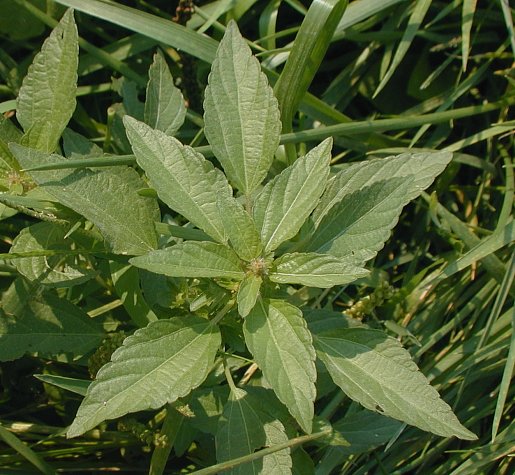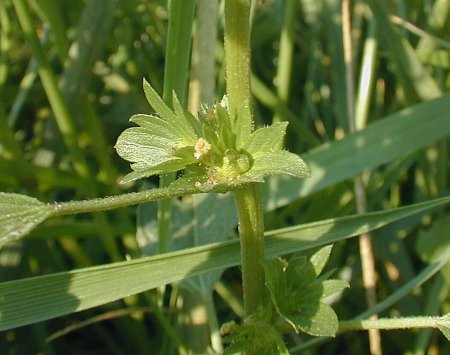Description: This annual plant is ½–2' tall, and usually unbranched. The central stem has lines of fine white hairs, or is glabrous. The alternate leaves are up to 3½" long and 1" across, with long narrow petioles that are slightly hairy. They are lanceolate or ovate, with bluntly serrated margins and conspicuous pinnate venation. There is a tendency for the leaves to congregate together near the top of the central stem, or any side stems that may be present. Where the petiole of each leaf meets the stem, there is a conspicuous bract that wraps around the inflorescence consisting of a green cyathium. This bract is slightly ciliate along the edges, and has 5-9 lobes. The cyathium contains tiny staminate and pistillate flowers without sepals and petals. The staminate flower is covered with yellow pollen, while the pistillate flower produces a 3-lobed spheroid fruit that is typical of the spurges. Each fruit contains three seeds. The blooming period occurs from about mid-summer until frost during the fall, and lasts one or more months. There is no floral scent. The root system consists of a central taproot.

Cultivation:
The preference is light shade to full sun, and moist to slightly dry
conditions. This plant often grows in fertile, loamy soil, but can
tolerate gravelly or clay soil as well. This plant is easy and
undemanding, and may volunteer spontaneously in a wildflower garden or
ecological restoration. However, it is rather common and weedy.
Range
& Habitat: The native
Rhomboid Mercury occurs in every county of Illinois, and it is quite
common
(see Distribution
Map). This is a rather inconspicuous plant that is easily
overlooked because of the lack of showy flowers. Habitats include
disturbed areas of moist prairies, limestone glades, openings or
lightly shaded areas of floodplain forests, thickets, seeps, stream
banks, ditches, fields, fence rows, roadsides, areas along railroads,
vacant lots, poorly
maintained lawns and gardens, and waste areas. This plant prefers
moist disturbed areas.
Faunal Associations:
Like other members of the Spurge family that occur in Illinois, the
seeds are attractive to such birds as the Mourning Dove and Greater
Prairie Chicken; they may also be attractive to the Bobwhite, Horned
Lark, and Wild Turkey. The herbaceous Acalypha spp.
in Illinois lack the poisonous white latex of other members in the
Spurge family, and their foliage is probably less toxic as a result.
Deer are known to browse on Acalypha spp.
occasionally, and it is possible that other mammalian herbivores do
this as well. There have been reports of cattle being poisoned by these
plants, possibly because of accumulation of nitrates in the foliage. It
is unclear to me if the flowers of Acalypha spp.
are wind- or insect-pollinated, although I suspect the former.

Photographic
Location:
The photographs were taken in a front yard along a roadside near
Urbana, Illinois.
Comments:
There are several Acalypha spp. in Illinois; the
number of seeds per fruit can range from 1 to 3 (usually the latter),
depending on the species. The species described here, Acalypha
rhomboidea, is very similar to Acalypha virginica,
except that the latter has 9-15 lobes in the bract that surrounds the
inflorescence at the base of the petiole. Some authorities consider the
former species to be merely a variety of the latter. The foliage of Acalypha
spp. often becomes purplish tan during the fall, which has
inspired the common name, 'Copperleaf.' This common name is often used
in the agricultural industry.